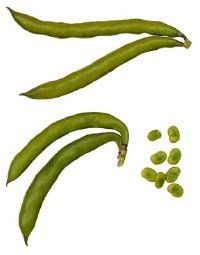Green beans are a wonderful plant for the home gardener. They grow well in good conditions and provide a crop of delicious, nutritious vegetables.
Snap beans require a short growing season -- about 60 days of moderate temperatures from seed to first crop. They grow anywhere in the United States and are an encouraging vegetable for the inexperienced gardener. Snap beans require warm soil to germinate and should be planted on the average date of last frost.
You can plant bush beans every two weeks to extend the harvest, or you can start with bush beans and follow up with pole beans. Plant seeds an inch deep, directly in the garden. For bush beans, plant the seeds 2 inches apart in single rows or wide rows. Seeds of pole beans should be planted 4 to 6 inches apart in rows 30 to 36 inches apart. Or, plant them in inverted hills, five or six seeds to a hill, with 30 inches of space around each hill.
For pole bean varieties, set the trellis at the time of planting to avoid disturbing the roots. Keep the soil evenly moist until the beans have pushed through the ground. When seedlings are growing well, thin the plants to 4 to 6 inches apart. Thin plants by cutting excess seedlings with scissors to avoid disturbing the roots of neighboring seedlings.
Harvesting Green Beans
The immature pod is the part that is eaten. When pods are large enough to eat, harvest by pulling the pods off the plant, taking care not to break the stem. Beans will flower twice and provide a second harvest. Smaller pods are more tender.
Green Beans
Green beans are separated into two types -- bush varieties and pole varieties. The varieties within these two types are listed below.
Bush varieties:
- Burpee's Tenderpod, harvest at 50 days, has 5-inch-long green pods.
- Blue Lake, harvest at 58 days, has green, 61/2-inch pods with white seeds.
- Roma II, harvest at 53 days, has green, flattened pods, 41/2 inches long.
- Brittle Wax, harvest at 52 days, has rounded, yellow pods, 7 inches long. Royal Burgundy, harvest at 51 days, has 6-inch-long purple pods.
- Festiva, harvest at 56 days, is deep green and disease resistant.
- Soliel, harvest at 60 days, is a high-yielding yellow.
Pole varieties:
- Kentucky Wonder, harvest at 65 days, is a proved standard variety with heavy yields of 9-inch green pods.
- Blue Lake, harvest at 60 days, has pods that are 6 inches long with white seeds.
- Scarlet Runner Bean, harvest at 65 days, is often grown ornamentally for its scarlet flowers; pods are green and up to 12 inches long.
Try:
- Vegetable Recipes: Find delicious recipes that feature green beans.
- Vegetable Gardens: Grow a full harvest of great vegetables this year.
- Gardening: We answer your questions about all things that come from the garden.

